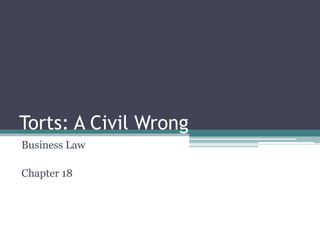
Chapter 18 notes
- 1. Torts: A Civil Wrong Business Law Chapter 18
- 2. Torts: A Civil Wrong In civil law, when a person commits a wrong, it is called a tort Civil law deals with crimes against individuals Harmed individual is the plaintiff Seek to win judgment against the defendant Individual is ordered to compensate the plaintiff usually in the form of paying monetary damages Some illegal activity can be both a crime and a tort
- 4. Sometimes an injury is partially or entirely the fault of the victim
- 6. The Idea of Torts: Yesterday, Today, and Tomorrow Judges in England were deciding in the 15th century Generally based on common law – law made through court decisions May also be cased on statutes – written laws Drinking and driving Seeks to balance usefulness and harm Drugs that help people Tries to preserve individual choice Smoking Often at the forefront of public controversy
- 7. Types of Torts Three major categories: intentional wrongs, acts of negligence, and strict liability Intentional wrong – Action done with the intent of injuring a person, their property, or both May also be crimes – may be prosecuted by the state Most common is negligence – unintentional tort Occurs when a person fails to use reasonable care Strict liability differs from both Three groups of people face strict liability: Owners of dangerous animals People who engage in highly dangerous activities Manufacturers and sellers of defective products
- 8. Taking Your Case to Court Tort law is civil law Can be both a tort and a crime – civil and criminal Must prove beyond a reasonable doubt Standard of proof – Amount of evidence a prosecutor must present Preponderance of the evidence – More than 50% of the weight of evidence Is that fair?
- 9. Taking Your Case to Court Who can be sued? Individuals, groups, organizations, businesses, and even units of the government Plaintiffs try to sue a defendant that will cover the damages – deep pockets People can sue employers for torts Children who commit torts can also be sued Must prove the minor acted unreasonably for their age and experience Certain defendants are immune, or protected Governments and certain officials Children cannot sue their parents…usually Husbands and wives – one legal entity
- 10. Taking Your Case to Court The notion of government immunity comes from England “the King can do no wrong” Today this is different…kind of Federal Tort Claims Act The president, federal judges, and members of Congress are completely immune 1997 case of Clinton vs. Jones President was not immune while in office Other high ranking officials have qualified immunity
- 11. Taking Your Case to Court Can be more than one plaintiff Injured parties form a “class” – called a class action If you are going to sue, you should hire an attorney They will mostly work for a contingency fee Not always beneficial to the plaintiff
- 12. Insurance Liability insurance is a contract, or agreement Insured person agrees to make payments –known as premiums Companies may require person to have attorney Most doctors, lawyers, and other professionals carry liability insurance Protects them from malpractice suits Manufacturers also carry this type of insurance as do homeowners and renters Very few insurance policies cover intentional harm
- 13. Insuring a Car Auto insurance is the most important Approximately six million auto accidents in 2006 42,000 deaths – 41% because of alcohol $230 billion in losses Can pay for repairs, medical bills, lost wages, and pain and suffering Liability, medical, collision, comprehensive, uninsured motorist, and no-fault Liability covers only so much, you have to pay the rest
- 14. Insuring a Car Liability policies have three limits: Injuries per person Total injuries to all persons involved Property damage Medical coverage pays for your medical bills and any passengers Collision coverage pays for damage to your own car Can lower cost by including a deductible
- 15. Insuring a Car Comprehensive coverage – Protects you against damage or loss to you car other than collision Vandalism, fire, or theft Uninsured motorist coverage – Protects you from other drivers who don’t have insurance Usually inexpensive No-fault insurance – Insurance company pays up to a certain amount no matter who’s at fault Usually have to waive your right to sue the other party
- 16. Worker’s Compensation Pays employees who are injured on the job Make contributions or take out insurance Do not have to go to court Receive a portion of your salary Give up the right to sue your employer If you don’t follow safety rules, you won’t be covered Amount of money and time are set by a schedule Workers’ comp is an exclusive remedy – only compensation for on-the-job injuries Some states have panels that will hear cases